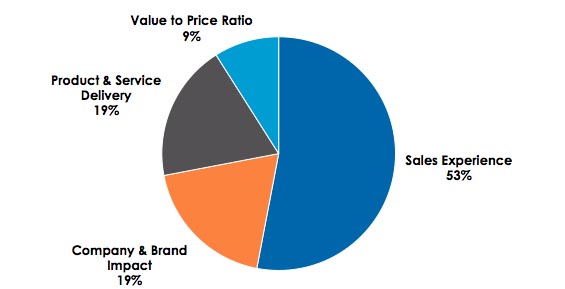- Because buyers can diagnose their needs and conduct their own research on possible solutions, selling successfully in today’s market requires a corresponding shift in strategy.
- A well-thought-out sales process is critical because the likelihood of closing a deal decreasesas the number of decision-makers increases.
- Buyers are three times more loyal to sellers who proactively bring opportunities to their attention.
By Karen Kimerer
Introduction
The sales process has changed dramatically over the years. At one point, the relationship between buyers and sellers was largely based on personal trust. As technological advancements took hold, the most successful sales reps developed a deep knowledge of their offerings and closed deals by communicating about features and benefits. Next, greater competition on a global scale prompted a focus on “solutions selling,” where businesses created unique offerings by packaging a set of services around their products to accommodate the customer’s unique situation. Today, the process has changed again—much of the information that buyers once had to obtain from trusted sales reps is now readily accessible via the Internet. Furthermore, with the COVID-19 pandemic upon us, in-person meetings have become an impossibility even for those buyers who might want to meet with sellers.
Now that buyers can diagnose their needs and conduct their own research on possible solutions, selling successfully in today’s market requires a corresponding shift in strategy. This article is the first in a two-part series, exploring the complexity of today’s selling environment and drivers of purchasing decisions. Next week’s piece will outline the strategies for a new sales paradigm as we navigate these uncertain times.
The Market Has Become More Complex
Even without the presence of a global pandemic, today’s decision-makers are increasingly difficult to reach. This can dramatically reduce sales productivity metrics. Decision-makers frequently complain that sales reps are seemingly not attuned to the fact that they can access endless amounts of information and perspective prior to contacting them. As a result, decision-makers have stopped inviting sales reps to the table early in the needs analysis stage. This makes it ever more difficult for sellers to guide buyers through an efficient transaction.
In addition to decision-makers being more difficult to reach, there are more of them. According to Gartner Group, a typical firm with 100–500 employees will have an average of seven decision-makers or stakeholders. The increase in the number of stakeholders can be attributed to a desire for risk mitigation and increased cost sharing between departments. In addition, all of these departments are seeking opportunities to reduce their overall spend.
Whereas salespeople might have only needed to engage with influencers in the marketing department years ago, they now must obtain buy-in from Chief Marketing Officers, Chief Operating Officers, Chief Financial Officers, legal counsel, procurement executives, and even the IT Department. According to research from the Corporate Executive Board (CEB), an average of 5.4 people influenced the decision-making process only two years ago. Fast-forward to today, and that number has further increased to 6.8 people involved in every significant purchasing decision. This creates a more complex selling environment for sales reps, and a well-thought-out process is critical because the likelihood of closing a deal decreases as the number of decision-makers increases.
What Drives Today’s Purchasing Decisions?
CEB research further asserts that the sales experience is the most critical factor of the purchasing decision. Today’s customers place the highest value on salespeople who make them think, bring new ideas, and find creative, innovative ways to help achieve their business goals. In short, customers are demanding more depth and expertise!
Primary Driver of the Purchasing Decision

Source: Corporate Executive Board
Additional research finds that customer loyalty is a result of not what you sell but how you sell it. Furthermore, buyers are three times more loyal to sellers who proactively bring opportunities to their attention. Sales reps can improve the sales experience and foster loyalty by:
- Offering unique and valuable market perspective
- Helping customers navigate alternatives and avoid potential landmines
- Educating customers on new issues and outcomes
- Facilitating the buying process
- Obtaining widespread support across the organization
The Bottom Line
As we navigate through COVID-19, it’s more important than ever for salespeople to reach out to their contacts and stay connected. Position your business as a go-to resource now so you can remain top of mind as business starts returning to normal. Once it does, you’ll want to make sure that your customers and prospects are perfectly lined up to do business with you. Stay tuned for next week’s article, where we’ll take a deeper dive into the strategies for today’s new sales paradigm.
Karen Kimerer of Keypoint Intelligence – InfoTrends has experienced the many challenges of expanding current market opportunities and securing new business. She has developed a systematic approach to these opportunities, addressing the unique requirements of becoming a leader in our changing industry. She is well-versed in 1:1 marketing, web-to-print, direct mail, book publishing, supply chain management, data segmentation, channel integration, and photo products.










Discussion
By Robert Lindgren on Apr 30, 2020
There's no doubt that the "sales experience" described in the article is the key to success. The obvious unanswered challenge is the multiplication of alternative resources and decision makers. This has currently been made worse by the barriers to face-to-face communication. If we are to become trusted resources, we have to connect by ways other than emails.
By Robert Godwin on May 01, 2020
Or, you could just say use Consultative Sales techniques. What Part 1 dances around is that if you don't know their business why should they know you? Maybe its in Part 2?
Discussion
Join the discussion Sign In or Become a Member, doing so is simple and free